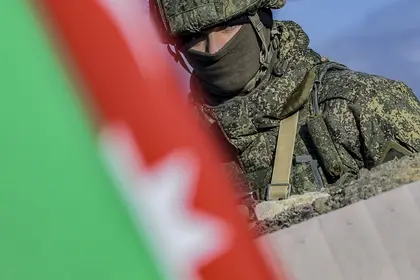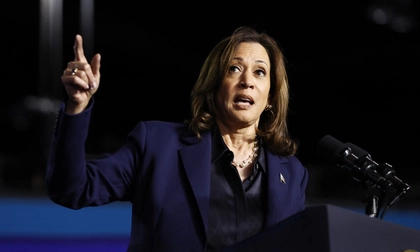The Azerbaijan army unleashed an artillery and drone barrage on outnumbered and poorly equipped pro-Armenian forces based in Nagorno-Karabakh on Tuesday, Sept. 19.
By Wednesday, Azerbaijan said it had halted military action in the disputed region after its battlefield success forced Armenian separatist forces to agree to a ceasefire that will see the area fully return to Baku’s control.
JOIN US ON TELEGRAM
Follow our coverage of the war on the @Kyivpost_official.
Nagorno-Karabakh human rights ombudsman Gegham Stepanyan said at least 200 people, including 10 civilians, were killed and more than 400 others were wounded in the single day of fighting, according to an AP report. He said earlier that children were among the dead and wounded.
Russian media reports on Sept. 21, cited by Radio Liberty, said that the deputy commander of Russia’s North Fleet submarine forces, Captain First Rank (Colonel) Ivan Kovgan, was among Russian troops killed during Azerbaijan’s shelling of the of Nagorno-Karabakh a day earlier.
In a speech to the nation on Wednesday evening, Azerbaijani President Ilham Aliyev said Baku had restored its sovereignty “with an iron fist” in a 24-hour offensive by troops backed by artillery strikes that brought the breakaway region to heel, Reuters reported.
Negotiations are set to take place today.
Map of Nagorno-Karabakh region, disputed by Armenia and Azerbaijan#AFPgraphics @AFP pic.twitter.com/PLAX5kkrHw
— AFP News Agency (@AFP) September 13, 2022
A reminder of why Nagorno-Karabakh is such a powder keg
Tensions between the majority Armenians, who reside in the mountainous region that is officially Azerbaijani territory go back to well before the break-up of the Soviet Union.

US-Russia Relations: Where Do Trump and Harris Stand?
Both Armenia and Azerbaijan were soviet republics, controlled from Moscow. After the USSR’s dissolution, the Christian Armenians who lived in Nagorno-Karabakh did not want to be ruled from Baku by nominally Muslim Azerbaijanis and took up arms to unite with the newly independent Armenia.
Following increased calls to be united with Armenia that began in the late 1980s, war finally broke out in 1992 which led to upwards of 700,000 Azerbaijanis being expelled from Armenia, Nagorno-Karabakh and the surrounding territories, while 300,000–500,000 Armenians living in Azerbaijan or Armenian border areas were displaced.
A ceasefire was signed in 1994 and led to two decades of relative stability, with Armenians in Nagorno-Karabakh effectively governing themselves while officially ruled from Baku.
Hostilities flared up again in 2016, when Azerbaijan accused Armenia of continuing to foment separatism among the Armenians under Baku’s rule.
In 2020 another war broke out in which Azerbaijan used superior weapons, many of which had been provided by Turkey and Israel, to defeat the Armenians in Nagorno-Karabakh and other territories controlled by Yerevan.
Russia as power broker
Throughout the years of conflict, Russia has acted as power broker in the region, mediating negotiations while supplying arms to both sides on various occasions.
Moscow’s approach to Armenia and Azerbaijan is a demonstration of its “near abroad” strategy, which tried to maintain influence in the former Soviet republics, by its ability to co-opt their leaders and various elites – the Kremlin employed a similar strategy in Ukraine, which eventually backfired into fierce anti-Russian sentiment.
After Armenia’s defeat in 2020, Russian troops went into Nagorno-Karabakh as peacekeepers, ostensibly to protect the Armenian population fearing reprisals from Azerbaijan and to ensure that Armenian-backed troops did not rearm.
With the war in Ukraine, however, Moscow became distracted, and tensions flared once again.
On Tuesday and Wednesday, thousands of Nagorno-Karabakh residents sought protection at a camp operated by Russian peacekeepers, AP reported. Others gathered at the airport of the regional capital, Stepanakert, hoping to flee the region.
Meanwhile, in the Armenian capital of Yerevan, Prime Minister Nikol Pashinyan faced calls from opponents to resign as thousands of protesters gathered to demand that the government do more for the Karabakh Armenians.
Although many Armenians blamed Russia for the defeat of the separatists, Moscow pointed to Pashinyan’s own recognition of Nagorno-Karabakh as part of Azerbaijan.
“Undoubtedly, Karabakh is Azerbaijan’s internal business,” said Kremlin spokesman Dmitry Peskov. “Azerbaijan is acting on its own territory, which was recognized by the leadership of Armenia.”
Peskov’s remarks come in parallel to a cryptic and menacing Telegram post by former President Dmitry Medvedev, suggesting that Armenia is reaping its just “rewards” for flirting with the West:
“One day, one of my colleagues from a fraternal country told me: ‘Well, I’m a stranger to you, you won’t accept me.’ I answered what I had to: ‘We will judge not by biography, but by actions.’ Then he lost the war, but strangely stayed in place. Then he decided to blame Russia for his mediocre defeat. Then he gave up part of the territory of his country. Then he decided to flirt with NATO, and his wife defiantly went to our enemies with biscuits. Guess what fate awaits him…”
What does NATO have to do with it?
Perhaps not coincidently, Azerbaijan’s attack took place just as 85 US soldiers were conducting a joint military exercise, Eagle Partner 2023, with Armenian forces in Armenia.
The drills that began on Sept. 11 were designed to prepare the Armenians to take part in international peacekeeping missions.
As a result of Azerbaijan’s attack this week, Armenia may effectively lose what little influence it has over Nagorno-Karabakh.
While some might interpret the attack as a message to the US that, in trying to gain influence with disgruntled Armenians, it is another NATO member, Turkey, that will emerge from the fray as a clear winner.
Turkey has long been backing Azerbaijan, whose people share linguistic and cultural commonality. Much of Azerbaijan’s military advantage in the 2020 war came from its use of Turkish-supplied drones.
An increasingly complex chessboard
Israel, along with Turkey, has also been providing Azerbaijan with military weapons and equipment. Many reports claim that Israel has used the former Soviet republic as a base to launch covert drone attacks on Iran, accusations the Iranians have been making since as far back as 2014.
“Since 2016, Azerbaijan has received nearly 70 percent of its arms imports from Israel, which in turn purchases 40 percent of its oil from Baku,” political scientist Mohammad Ayatollahi Tabaar writes in the US magazine Foreign Affairs.
There is a centuries-long history of enmity between Iran and Azerbaijan. Although both are Shiite Muslim, the Azerbaijanis have periodically laid claims to much of northern Iran, which is inhabited by Azeris (the same ethnicity as Azerbaijan), comprising up to 20 percent of the Iranian population.
“Tehran accuses Baku of aspiring to ‘Balkanize’ Iran by backing separatist movements among Iran’s ethnic Azeri population,” Tabaar says.
Now, with Russia bogged down in its war on Ukraine, there is a danger that the resulting power vacuum in the Caucasus may spill over elsewhere. This latest conflict in Nagorno-Karabakh may just be the first signs of deep cracks appearing in a region that has been wedged between political fault lines for millennia.
You can also highlight the text and press Ctrl + Enter






